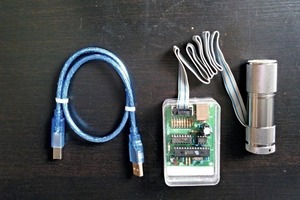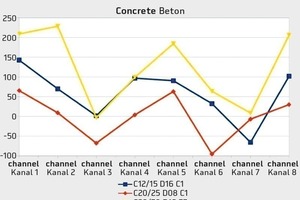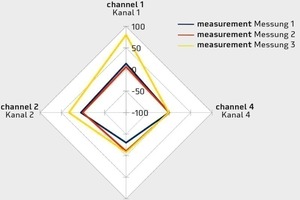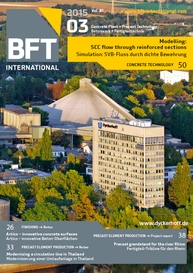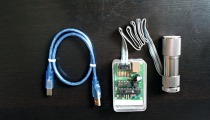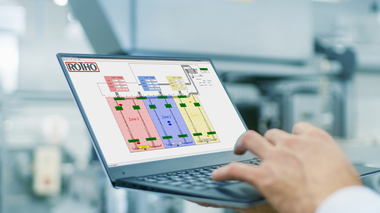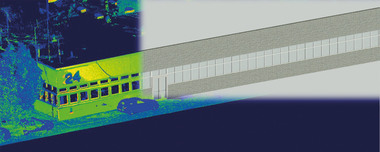Electronic tongue to “taste” concrete
One of the principles that can be applied to the design of an electronic tongue is to generate an electrochemical voltage, just like in a galvanic cell but also similar to the human or animal tongue. Both the biological and the engineered tongue generate an electrical voltage using the presence of ions. A minute amount of moisture makes substances dissociate so that they are present in ionized condition. Thanks to the research of Prof. Walther Nernst, it has been known for about 100 years that different electrodes that consist of conductive materials generate an electrical voltage from the ions present in the substance. Similar to the individual lingual papillae, this electrochemical voltage can be generated multiple times and structured as a pattern using various electrodes. This makes the related object suitable for treatment using the principles of mathematical pattern or object recognition theory, which makes it possible to teach in a pattern and to subsequently detect it using appropriate classification methods. This can happen in only a few split seconds, and the signal can then be processed electronically and displayed or linked via the Internet using state-of-the-art technical capabilities.
Electrodes may be composed of a wide range of conductive materials that usually react to ions with a low degree of selectivity. This is why an overall impression can be gained from a pattern of electrochemical voltages, similar to the physiological impression a human being gets on the basis of their sensual perception. In the latter case, however, this step results in a subjective taste classified by the human brain, whereas Nernst voltages provide an objective “taste” and thus deliver a superordinate piece of taste information from all ion-containing substances, which results in an objective description and quality information that can also be used in construction engineering.
Design of the
electronic tongue
The electronic tongue requires a measuring head to generate the Nernst voltages upon making contact with the measured object, an electronic unit to take up and process these voltages, and a computer that applies mathematical principles to determine and recognize patterns or clas-ses. This process is informed by mathematical object or pattern recognition theory.
The measuring head must provide eight measuring channels to accommodate the eight vector components that represent the individual classes. Since electrical voltages are only generated between any two electrodes, eight conductive electrodes and a conductive reference electrode are needed, which are all integrated in the measuring head. In popular terms, the resulting voltage pattern can also be referred to as a fingerprint of the measured object. Figure 1 shows a prototype of this electronic tongue that can determine the “taste” of concrete. This is not a taste classified by the human brain; rather, it is based on the information obtained from the entire set of ions with a low degree of selectivity (as is the case in humans).
Quality check of concrete mixes
For a quick check of the quality of a given concrete mix, either a sample is taken or a suitable sensor immersed into the mix. Figure 2 shows three such measurements performed for standard mixes in accordance with DIN EN 206-1 and DIN 1045-2 (2001). These results demonstrate that it is possible to distinguish the individual mixes from each other fairly efficiently, and that these differences can be detected until the concrete arrives on the construction site if further changes in its condition are taught in.
This method enables listing of an entire library of varied mixes or conditions on an electronic storage medium. For any further examined sample, its voltage parameters are checked for similarity to stored values and subsequently recognized. It is only this recognition step that is interesting to the user, whereas Nernst voltages are relevant only to the internal process. This provides the advantage that information is available on-site as soon as it is required. Prior to this step, the teach-in and analytical process must be performed and implemented as an app.
Quality control of fresh and hardened concrete
Any electrodes permanently embedded in the concrete can provide information on the concrete’s setting behavior, as well as being queried with respect to its condition in subsequent years. However, this would require prior testing at a research laboratory that classifies chemical and mechanical characteristics. Thereafter, the building or structure can be tested for its condition at any time using appropriate measuring points and the associated electrical voltages of the electrodes. For this purpose, electrodes can be embedded not only in concrete but also in other building materials that exhibit an ionic reaction. Figure 3 shows a concrete block with five inserted electrodes that deliver a fingerprint complete with vector components, measurement channel voltages and voltage patterns.
Summary: The electronic tongue must be taught in with respect to the object to be recognized. Once this step has been completed, however, it is small enough to fit in any pocket whilst being capable of easily detecting patterns within only a few seconds, which makes the electronic tongue suitable as a quality control tool for daily use in any ion-containing substance with an electrolytic effect.

